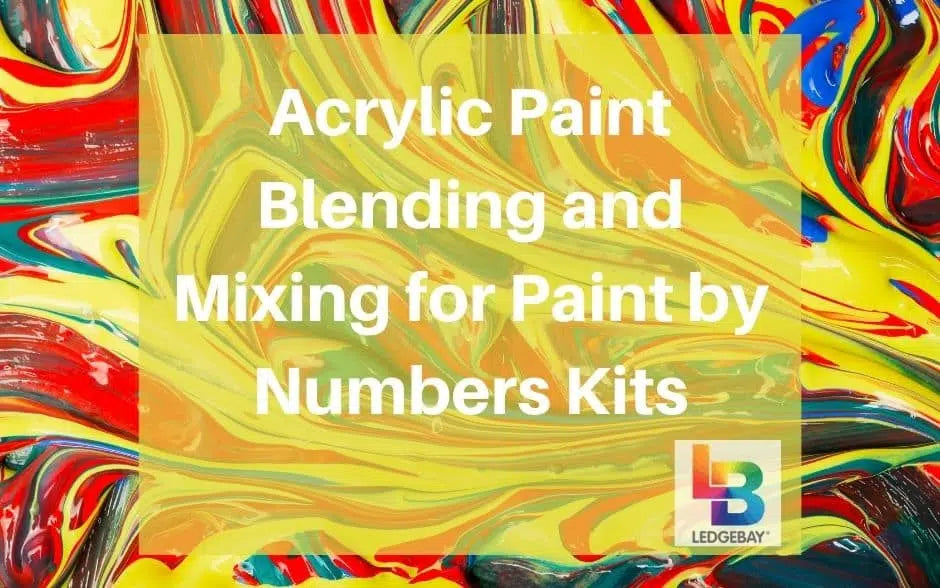Here’s our detailed guide for leveling up:Acrylic Paint Blending and Mixing for Paint by Numbers Kits. You’ll find here everything you need to know about creating any shade you desire!
The internet is rife with designs forpaint by numbers kits , but they don’t often supply the necessary materials. You can download the painting layouts, but you’d need to buy the other things.
Not all the colors would be readily available in tubes though. Or, it would be too expensive to buy each and every required color. It’s far better to buy theessential primary colors , and learn how to blend and mix the rest.
[amazon box="B0006TZN3Y"]
It actuallyadds vigor to weak colors and makes them far more wholesome. There’s also a touch of opacity that you can achieve by increasing the white continent into a mixed color. And it comes in handy as you brush in an extra layer of color.
Professional artists often have titanium white in bushels! Oil painters can even mix it up from its main ingredients, and keep it in big jars. That’s because of its versatility and endless necessity to blend colors into lighter tones.
Add the titanium white in small increments. Blend it in with a palette knife and see how it changes the original color. Then, you can add some more if you need. Starting with a large amount of white from the outset could be too much, and then you’d have to figure out a way to make it darker.
Using a color that’s a tad darker often does the trick. Then you can adjust the desired tone by adding a touch of the primaries, or a hint of white.
For example, you have a sienna and you’d like to go for dark copper. Don’t ever add black here. Just a touch of red would do the trick. Depending on the mood of the painting, adding a bit more blue or green could add depth to yourperfect new color .
What would happen if youmixed all the primary colors together? You get a deep skin tone.
Some colors are easily available in a tube, while others need some skillfulmixing to be created . Most professional artists work with a limited amount of tubes, and blend their way to all the different tones they like.
It’s worth trying, since the colors you blend on your own are like your favorite words or musical notes. They express who you are, not only what your painted subject looks like. Soexperiment with the primary colors , and see what you’d come up with.
This process could take a while, and by the end of it, you’d probably forget how many colors you used, and with what ratios?
Blending the perfect color is a skill you gain with experience and most of it needs playing by ear. Replicating specific shades is thus arbitrary, and doesn’t always succeed. It’s best then to mix sufficient amounts of the color you like.
You’ve now mixed several colors and reached the perfect skin tone for a portrait, or the right shade of orange for a copper urn. In most cases, you’d need lighter and darker shades for thedifferent parts of your composition .
The best approach is to blend in a bit of white on one side of the mixed color, and burnt umber on another. This way, you’d have graded colors on your palette.
Depending on the complexity of thepaint by numbers kit you have, you can blend any range of shades you like. Starting from just the basic lighter and darker shades, all the way to a family of shades with varying tonalities.
Leaving traces of the original colors showing gives a nuanced effect to the blended color. This is especially beautiful when the two colors are in close proximity onthe color wheel .
Mixing a light tone with a darker tone also makes for lovely hints of continuity. In addition to rendering arealistic feel to the painted areas. After all, in the real world, you’d rarely see a pure color that never changes at all.
Even the white roses have blue, grey, yellow, and red inside their pale petals. If you need further proof, take a look at the pristine snow, the darkest night sky, and the reddest rose. There’s a million shades of color and tone inside them.
For example, a touch of red added to cobalt blue will make it significantly deeper. That’s of course as long as you don’t go overboard with the added color. If the amount of red increased beyond the right intensity, it would drag the blue into becoming purple or violet.
Another common demonstration of this rule is in skin tones. Reaching the right skin tone takes plenty of practice, as it often involves adding 3 or more colors, then lightening the shade or darkening it. But what would happen if you added blue or green in the end?
As opposed to what several people might think, the skin tone wouldn’t start looking like a scene from monsters inc. The added blues, greens, or even reds, would simply adjust the tonality of the skin to different lighting and moods. In addition to rounding up themidtones and highlights.
You might start all over again, and mix in all the other colors you put in before. But still, the previous tone doesn’t want to be re-created. That’s why it’s best tokeep the colors from drying for as long as possible.
Some palettes are designed to keep the colors hydrated. Alternatively, you can use a sprayer to mist your palette from time to time.
After mixing and blending your acrylics, you canstore them in such containers. A detailed stick-on label should hold all the necessary information on that shade. The best part is, that as long as these colors are stored properly, they won’t dry on you. This way, you can use them in many projects.
To work with apaint by numbers kit , you need a palette with specific shades and tones of colors. You can mix them on the spot, and improvise as you go. Or, you can prepare them ahead of time, and store them in plastic containers.
For a complete gallery of our paint by numbers kits,CLICK HERE!
The internet is rife with designs forpaint by numbers kits , but they don’t often supply the necessary materials. You can download the painting layouts, but you’d need to buy the other things.
Not all the colors would be readily available in tubes though. Or, it would be too expensive to buy each and every required color. It’s far better to buy theessential primary colors , and learn how to blend and mix the rest.
10 Pro Tips for Acrylic Paint Blending
Here are my best tried and testedtips for acrylic paint blending for a paint by numbers kit. A rudimentary knowledge ofcolor theory would be great, but these tips should get you started.1. Add a Touch of White for a Richer Color
With acrylics, there’s another usage for a white color, in addition to brightening colors.[amazon box="B0006TZN3Y"]
It actuallyadds vigor to weak colors and makes them far more wholesome. There’s also a touch of opacity that you can achieve by increasing the white continent into a mixed color. And it comes in handy as you brush in an extra layer of color.
2. Use White for a Lighter Tone
[amazon box="B000YQMDFU"]Professional artists often have titanium white in bushels! Oil painters can even mix it up from its main ingredients, and keep it in big jars. That’s because of its versatility and endless necessity to blend colors into lighter tones.
Add the titanium white in small increments. Blend it in with a palette knife and see how it changes the original color. Then, you can add some more if you need. Starting with a large amount of white from the outset could be too much, and then you’d have to figure out a way to make it darker.
3. Don’t Use Black for a Darker Tone
Realartists rarely use black to get a darker shade of a color . That’s even more important with acrylics, as the resulting color is often a muddy and shapeless mass that you wouldn’t want to use.Using a color that’s a tad darker often does the trick. Then you can adjust the desired tone by adding a touch of the primaries, or a hint of white.
For example, you have a sienna and you’d like to go for dark copper. Don’t ever add black here. Just a touch of red would do the trick. Depending on the mood of the painting, adding a bit more blue or green could add depth to yourperfect new color .
4. Experiment with the Primary Colors
[amazon box="B01LYHVTW1"]What would happen if youmixed all the primary colors together? You get a deep skin tone.
Some colors are easily available in a tube, while others need some skillfulmixing to be created . Most professional artists work with a limited amount of tubes, and blend their way to all the different tones they like.
It’s worth trying, since the colors you blend on your own are like your favorite words or musical notes. They express who you are, not only what your painted subject looks like. Soexperiment with the primary colors , and see what you’d come up with.
5. Mix Up a Suitable Amount
Reaching the right color that works for your drawing can sometimes be tricky. You’d try several primaries, then add white to lighten, and a darker shade to deepen. You’d then iterate by adding warm and cold colors for the mood you’re after.This process could take a while, and by the end of it, you’d probably forget how many colors you used, and with what ratios?
Blending the perfect color is a skill you gain with experience and most of it needs playing by ear. Replicating specific shades is thus arbitrary, and doesn’t always succeed. It’s best then to mix sufficient amounts of the color you like.
6. Go a Shade Darker and a Shade Lighter
[amazon box="B01DODZZ3Q"]You’ve now mixed several colors and reached the perfect skin tone for a portrait, or the right shade of orange for a copper urn. In most cases, you’d need lighter and darker shades for thedifferent parts of your composition .
The best approach is to blend in a bit of white on one side of the mixed color, and burnt umber on another. This way, you’d have graded colors on your palette.
Depending on the complexity of thepaint by numbers kit you have, you can blend any range of shades you like. Starting from just the basic lighter and darker shades, all the way to a family of shades with varying tonalities.
7. Don’t Blend the Colors Thoroughly
[amazon box="B07H5352G3"]Leaving traces of the original colors showing gives a nuanced effect to the blended color. This is especially beautiful when the two colors are in close proximity onthe color wheel .
Mixing a light tone with a darker tone also makes for lovely hints of continuity. In addition to rendering arealistic feel to the painted areas. After all, in the real world, you’d rarely see a pure color that never changes at all.
Even the white roses have blue, grey, yellow, and red inside their pale petals. If you need further proof, take a look at the pristine snow, the darkest night sky, and the reddest rose. There’s a million shades of color and tone inside them.
8. Add Different Colors to Get Vibrant Shades
Once you mixed the shade that matches an area in yourpaint by numbers kit , try to add a touch of blue, green, red, or yellow. These colors wouldn’t overpower the mixed tone, but rather, give you vivid varieties you can use around the main color.For example, a touch of red added to cobalt blue will make it significantly deeper. That’s of course as long as you don’t go overboard with the added color. If the amount of red increased beyond the right intensity, it would drag the blue into becoming purple or violet.
Another common demonstration of this rule is in skin tones. Reaching the right skin tone takes plenty of practice, as it often involves adding 3 or more colors, then lightening the shade or darkening it. But what would happen if you added blue or green in the end?
As opposed to what several people might think, the skin tone wouldn’t start looking like a scene from monsters inc. The added blues, greens, or even reds, would simply adjust the tonality of the skin to different lighting and moods. In addition to rounding up themidtones and highlights.
9. Keep the Colors From Drying
Blendingacrylic paint is a rather complex process, and it could take you several trials till you reach the right tone. Acrylics have the nasty habit of drying quickly though. So if you take your time in painting, you might find that the colors on the palette are already flaky and unusable.You might start all over again, and mix in all the other colors you put in before. But still, the previous tone doesn’t want to be re-created. That’s why it’s best tokeep the colors from drying for as long as possible.
Some palettes are designed to keep the colors hydrated. Alternatively, you can use a sprayer to mist your palette from time to time.
10. Store the Colors in Labeled Plastic Containers
Paint by numbers kits often come with an assortment of colors in tiny plastic containers. Each little tub is neatly labeled with the name of thecolor and the relevant number . And that’s how we know where eachcolor goes in the empty painting .After mixing and blending your acrylics, you canstore them in such containers. A detailed stick-on label should hold all the necessary information on that shade. The best part is, that as long as these colors are stored properly, they won’t dry on you. This way, you can use them in many projects.
Conclusion: Acrylic Paint Blending for Paint By Numbers Kits
Acrylics are supposedly easy-going colors. But as you set out working with them, you might feel that they’re a bit tricky and unpredictable. That’s because they’re a bit different fromwatercolors and oils in the way they are mixed and applied. However, once you learn the basics ofacrylic paint blending, you’d see the sweeter side of acrylics.To work with apaint by numbers kit , you need a palette with specific shades and tones of colors. You can mix them on the spot, and improvise as you go. Or, you can prepare them ahead of time, and store them in plastic containers.
For a complete gallery of our paint by numbers kits,CLICK HERE!











